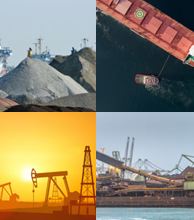The question that comes up more and more is when will we get a turnaround in the markets? This, of course, is the question on the lips of everyone from big fund traders all the way to small IG Index punters. At face value, it seems that for many markets the only way is up. Oil has bounced up off negative prices, dry freight markets couldn’t get much lower, and iron ore is defying gravity at almost $100.
The crude market has been buoyed by successive weeks of bullish data from the EIA. It has reported draws in US crude stocks for two weeks in a row now, signalling that the attempts by producers to deal with oversupply are working. This is not to say that all their problems are over, as there still is a big issue of the collapse in demand, and there is only so long people can go on producing at loss-making levels. The rally up in Brent to above $36 is built on weak foundations, feeding on the tears of producers and egged on by fund investors. It would only take a recommencement of the US-China trade war to bring it crashing back to reality.
Iron ore has been the ugly duckling of the freight-related commodity world. While other markets have panicked and collapsed, iron ore reacted to the coronavirus news with as much emotional expression as a Sylvester Stallone rendition of a Shakespeare play. Can you imagine? “Romeo, Romeo, wherefore art thou Romeo?” Iron ore is now knocking on the $100 door, having risen nearly $8 week-on-week. There are signs that there is weakness appearing down the curve, but for now it is flying high.
Even the dry freight market has been turning up the Yazz vibe as we got a bounce in the Capes on the back of better volumes of coal and iron ore from Australia, with the 5TC average up to around $3500. The Panamax market hasn’t quite seen the same sentiment, but it seems that we have gained a bit more of a floor to support recovering rates.
Wet freight on the other hand has been about as lively as a dubstep convention in a morgue. Physical activity has been slow or non-existent across many of the routes, leaving rates flat to lower, as the market that defied others at the beginning of the virus crisis has finally lost its shine (with the cutting of production and demand still lingering around low levels, this won’t come as much of a surprise).
But there’s always one commodity that decides it doesn’t like the theme of this weekly report, rebelling from the trend and giving credence to all those people that address any conundrum with “yes, but it’s more complicated than you think/know/understand”.
Air freight has for a while been suffering due to the total collapse of demand in passenger demand, but had been thrown a lifeline with PPE shipments, but now even this isn’t able to support rates any further. With the pandemic easing across much of the world, the demand for PPE has subsided but there isn’t yet much of an indication when conventional demand will be returning.
There are plenty of other factors that are not moving upwards and are indicators that this recovery from the virus outbreak is going to be more painful than it first appears. In the US and the UK unemployment is increasing, with the US rocketing its way towards levels last seen during the Great Depression.
Or for another comparison the last time the UK economy shrank 2% (as it has done this Q1) it was during the financial crash and the meltdown of the world’s financial sector. As the Economist pointed out in its latest edition, judging by a range of indicators the world never recovered to the 2000 heights, so it’s by no means certain that the economy will bounce back post Covid-19.
